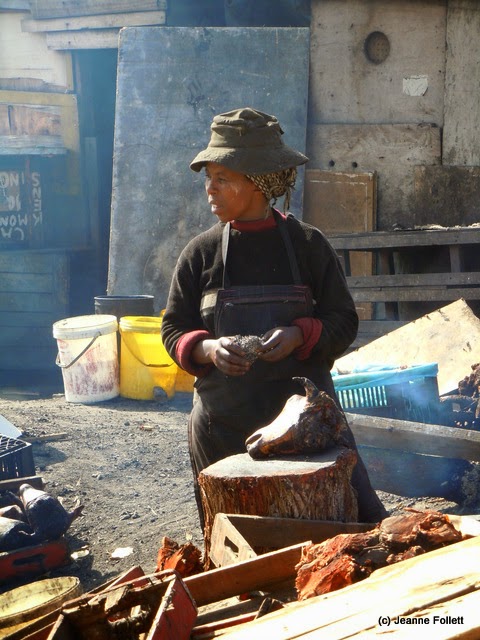The Africa Journals
Chapter 56
Shanties and Sheep
Heads
(Part Two of The Cultural Connection)
Perhaps travel cannot prevent bigotry, but by demonstrating that all
peoples cry, laugh, eat, worry, and die, it can introduce the idea that if we
try and understand each other, we may even become friends. ~ Maya Angelou ~
We leave downtown Cape Town, leave behind the ultra-modern
buildings, the four star hotels, the huge shopping mall at the harbor, and
drive up the busy highway that takes us to the other side of Table
Mountain. This is the area known as Cape
Flats.
As late as the 1950s, this area was all but uninhabited and
covered with soft sand of marine origin, blown in by the vicious winds for
which Cape Town is famous. The sand made
travel by wagon impossible.
The apartheid policies of the Nationalist government forced
many non-whites out of Cape Town proper, and in as little as a generation, it
became a densely populates area of squatter shacks and modest homes.
| Cape Town is located along the narrow coast in the foreground, with Table Mountain behind it and Robben Island to the left in Table Bay. Cape Flats is circled. |
Mile after mile of shanties line both sides of the highway,
set back across a green grassy area and a fence meant to keep the residents
from attempting to cross the busy road, and perhaps, hide the tumbledown shacks
from view. Though the effort has been made to prevent crossing the highway on foot, every year a number of people die while trying.
 |
| Shanties in the back yards of nice homes. |
But, there are holes in the fences, boards missing here and
there. People slip through the fence and
use the grassy area as a toilet in full view of the passing traffic, not even
attempting modesty. Maybe the rows of
portable toilets are too far away, or full, or whatever, but watching women
pull up their pants and men zipping up theirs is quite a shock after leaving
clean and beautiful Cape Town only minutes ago.
We enter a neighborhood of modest one-family homes and our coach drops us off at a community center where vendors hope we will pause to shop.
Instead we are escorted into a
workshop where ceramics and pottery are made, giving the local residents jobs
and business experience. This man spoke
to us for about five minutes about the project and its successes to date, and I
don’t think he drew a breath in all that time.
Either that or he has learned, like didgeridoo players, the art of
circular breathing.
 |
| Apparently, she's heard this spiel before. |
In the same building, we seat ourselves in a small
auditorium and watch a one-man
performance. The actor tells the story
of growing up under apartheid and ends, as an old man, the day he was allowed
to cast a vote as a free man. It is
quite moving as he mimes an elderly man walking with the aid of a cane, and dropping his precious ballot into a box.
Back aboard the coach, we travel a short distance and turn
onto a narrow road through a shanty town. All these neighborhoods have names, according
to the maps, but the only name I hear is Langa and I have no way of knowing if
we leave it or stay within its boundaries.
As we wind through the make-shift shacks and shanties, we
see many people trying to eke out a living with tiny businesses. And then I see smoke and hope-to-God this
place isn’t on fire. It all looks like
a tinderbox, and with all the outdoor cooking over open fires, I cannot imagine
how people could escape a runaway fire here.
We round a bend and behind a huge pile of pallets and assorted
scrap lumber, I see the smoke comes from contained fires. A slight breeze blows away the smoke for a
moment and reveals two women preparing sheep heads. I wonder if this is the poor man’s food—the
offal and heads being all he can afford.
 |
| Winnie |
The guide brings one woman aboard, introduces her as Winnie, and explains she coats her face with clay to protect it from the heat of the fire.
I did not know, until I returned home and happened to catch
an installment of Anthony Bourdain’s TV series Parts Unknown, that sheep heads are considered a treat. Stripped of hair and thoroughly washed, the heads are par-boiled and then roasted over a fire. The heads are called Smileys locally. Why? Because when a sheep dies, it smiles and the roasting emphasizes that smile. It is a favorite of the ethic Zulus and Indian (from India) population.
Even restaurants with clientele anxious to try indigenous foods are serving them.
Even restaurants with clientele anxious to try indigenous foods are serving them.
We continue on through the shanties for the next part of our tour.















What a difference a few miles can make!! I can see why you're reading instead of writing about this part of your trip.
ReplyDeleteJust yesterday I read on the internet that the nation of India ranks first in the world as to severe poverty. So what we are seeing through your trip and the evidence of severe poverty that you show .. as severe as it is .. it is far from being confined to Africa. What a journey. Thanks for all of your time and effort .. Smiles .. Cap and Patti ..
ReplyDelete